
There are many debates about who was at the forefront of creating the first digital currencies. Some people want their name to be associated with this phenomenon, while others, on the contrary, refuse and deny any involvement in the process of creating cryptocurrencies.
In any case, one thing is clear and undeniable: cryptocurrencies are increasingly becoming a part of our daily lives. Many companies and individuals around the world use them for making payments and international transfers.
This article will attempt to explore how and where the idea of digital money originated, and who was truly involved in the creation of cryptocurrencies. To learn more about the distinctive features of cryptocurrencies, their types, uses, advantages, and disadvantages, you can read the article "Cryptocurrency for Beginners."
Understanding cryptocurrency
Any cryptocurrency is a digital asset that has no physical form or equivalent. The value of digital currencies is determined based on the supply and demand for them, which is often limited.
All operations with cryptocurrency are conducted in a special network - the blockchain, which is supported by several independent devices. For example, in the Bitcoin network, there are more than 15,000 such devices.
The blockchain consists of blocks, and each block contains records of transactions, much like a ledger that records all operations. However, an important aspect of the blockchain is that these records cannot be altered or forged, as they are simultaneously displayed and stored on different devices.
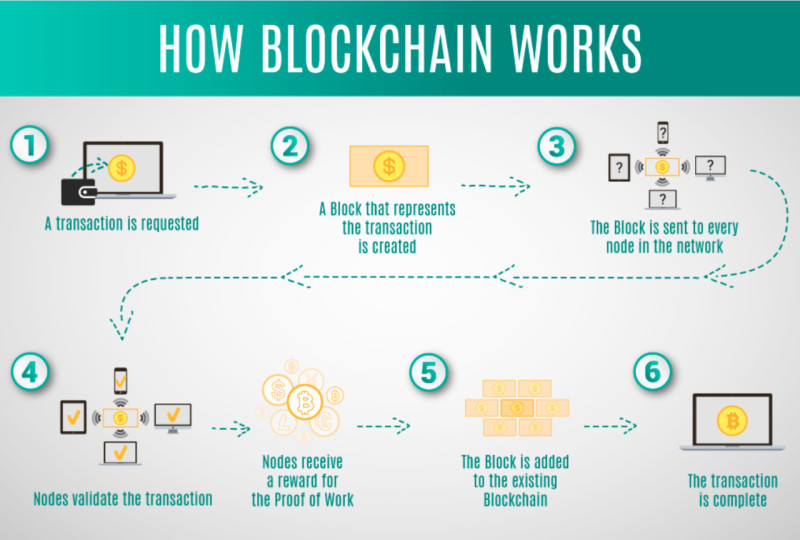
To change even a single record in any of the blocks, it is necessary to modify not just that block but all the subsequent ones as well. Even if a record is changed on one or several devices, it remains unchanged on all others, and the data stored on at least half of all devices are considered to be true.
This mechanism is directly related to one of the key features of when was the first cryptocurrency created – decentralization. There is no single government or body that controls the issuance and circulation of digital coins. The network service and processing of all transactions are carried out by miners.
Miners maintain the network, verify the correctness of transactions, and add new blocks. For their work, miners receive a reward in the form of new coins, which is how they are generated.
Another important feature of the blockchain that ensures its reliability and security is a special encryption system called cryptography. Using this method, any record can only be decrypted by the user who has a special key.
Moreover, cryptocurrency transactions can be conducted anonymously and without any intermediaries such as banks or other financial institutions. Cryptotransfers are not limited by national borders. All these features attract more and more people to digital currencies, but who was at the origins?
How cryptocurrency was created
Although the first cryptocurrency emerged in 2009, the idea of creating decentralized currencies appeared much earlier – in the 1980s. So, who were the people who developed and promoted these ideas?
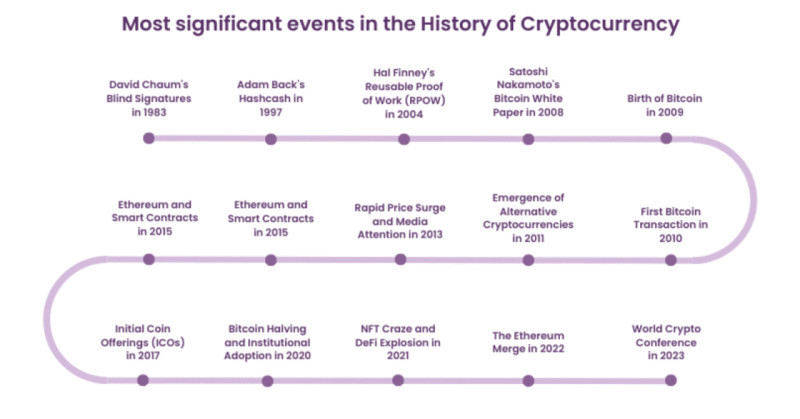
In the 1980s, a professor from California, David Chaum, presented his work describing a special mechanism for sending and receiving data. According to him, operations with tokens could be carried out without any central authority using special encryption.
Just a year after this, Chaum founded his own company called DigiCash and invented the prototype of the first digital currency, eCash. His developments even caught the interest of Microsoft, but the company eventually went bankrupt, and the issuance of digital coins ceased.
Later, in the late 1990s, an engineer from Washington, Wei Dai, released his own currency – B-money. The foundation of this currency was a concept that allowed all transactions to be conducted using digital pseudonyms that could not be traced.
Moreover, Dai proposed the use of cryptographic protocols for the identification and accounting of operations, as well as ensuring security. He also introduced the idea of using digital signatures and public keys for transaction execution.
Nick Szabo, in the late 1990s, also launched his digital money, which he called "Bit Gold". He also devised that each network participant needed to solve cryptographic puzzles and receive a reward for it. This was very similar to Bitcoin.
However, none of the aforementioned digital coins continued to exist. But all these developments laid a good foundation for the emergence of cryptocurrencies in their current understanding.
Thus, in 2008, a severe economic crisis occurred in the US banking system. It was at this time that the work of Satoshi Nakamoto was published, in which he detailed the basics of blockchain operation. In this article, the name of a new currency – Bitcoin – was also mentioned.
Nakamoto's idea fundamentally differed in that it allowed for the elimination of a central administrative body that had to verify information in the network. This was done using computers, more precisely, a network of computers, which needed to reach a consensus to record a block.
Who invented cryptocurrency and when was the first cryptocurrency created
The creator of the first known cryptocurrency is considered to be Satoshi Nakamoto, but this is not a real name but a pseudonym for one or more individuals. Nonetheless, this was not some random discovery but the result of extensive work.
Thus, Nakamoto invented not only Bitcoin but also blockchain technology, which involved the integration of several devices that built and maintained this network. As mentioned earlier, the description of his future digital currency was provided in 2008.
In 2009, he created the first Bitcoin wallet and continued developing this project. However, his identity has remained undisclosed. Even when the CIA became interested in his developments, they could not determine his real name or address. Nothing has been known about this person (or group of people) since 2011.
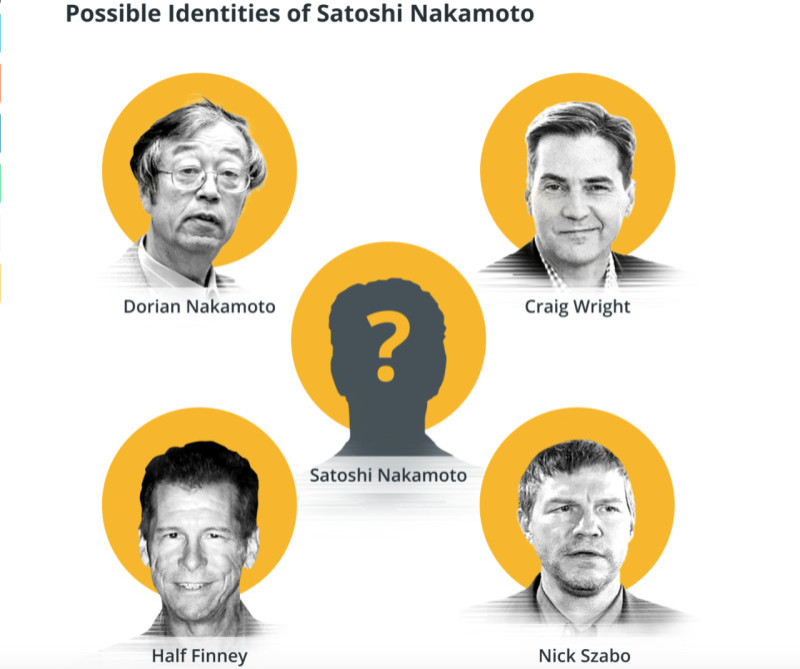
So, who really is behind the name Satoshi Nakamoto, who created the first digital money? There are several contenders for this title. One of them is a namesake – Dorian Prentice Satoshi Nakamoto.
However, this individual denies any connection to digital currencies, despite being a computer engineer by profession, having a Japanese surname and appearance. Nevertheless, all these facts are likely just a coincidence.
The next contender is Nick Szabo, who has his own developments in this area, dating back to 1996. He developed his concept of a decentralized currency before the appearance of Bitcoin.
Another person who claims to be the creator of Bitcoin is Craig Wright. He was actively involved in mining when crypto was just emerging. In 2019, Wright claimed copyright over the design and source code of Bitcoin, although this right is not exclusive.
David Kleiman had a joint company with Craig Wright, which was involved in mining Bitcoin and other operations. Kleiman himself has passed away, but his sister filed a lawsuit against Wright, accusing him of stealing bitcoins mined by her brother.
Creators of other digital currencies
We have already talked a lot about the first digital currency – Bitcoin – and its creator or creators. However, in the discussion about who created cryptocurrency, we cannot overlook other, now well-known coins: Ether, Ripple, Litecoin, and others.
Let's try to understand their key differences from Bitcoin and who created them. Ether (Ether) is the second most popular digital coin, whose creator is not hiding from anyone. His name is Vitalik Buterin – a Canadian programmer with Russian roots. He released his currency in 2015, and at that time, one coin was worth $2.77.

The creator of Ether became the world's youngest crypto-billionaire when the value of the currency he issued exceeded $3,000 in 2021, though the price later fell. Besides the coin itself, a blockchain platform of the same name was also created. This platform allows for the creation of new currencies or applications through smart contracts.
Another well-known digital coin is Litecoin, which was created in 2011 by Charles Lee, a programmer and former Google employee. This currency was developed based on the Bitcoin code, and although it was not the first attempt to copy the code of the first currency, it was one of the most successful.
The creators of Litecoin managed to reduce the block time, thereby increasing the number of operations per second and reducing transaction fees. If Bitcoin is called "digital gold," then Litecoin is considered "silver." Moreover, this coin is distinguished by its low cost – just over $72.
Ripple is a whole system used for settlements, within which circulates a digital currency of the same name. It was created in 2012 by Jed McCaleb. The primary goal of creating this platform was to make a faster and more efficient alternative to the SWIFT banking system.
Unlike Bitcoin, which is only a currency, Ripple is a platform, and the Ripple coin itself is primarily intended to support its functioning. The value of the XRP token is only $0.6140.
What is needed to create cryptocurrency
We have already talked about the creators of the most famous and popular digital currencies. However, it would also be interesting to find out how difficult it is and what exactly is needed to develop a new digital coin.
Firstly, if we are talking about a completely new currency, then it is necessary to create a new blockchain for it. This can be done independently if the user has the relevant knowledge and skills, or by turning to developers.
Alternatively, you can create a currency based on an existing blockchain. In this case, there is an option to modify the source code or use another when was the first cryptocurrency created platform to create new tokens. These can only be tokens if they do not have their own platform.
Secondly, it is necessary to choose a consensus mechanism – otherwise known as a working protocol. The two most famous and frequently used protocols are PoW (proof-of-work) and PoS (proof-of-stake).
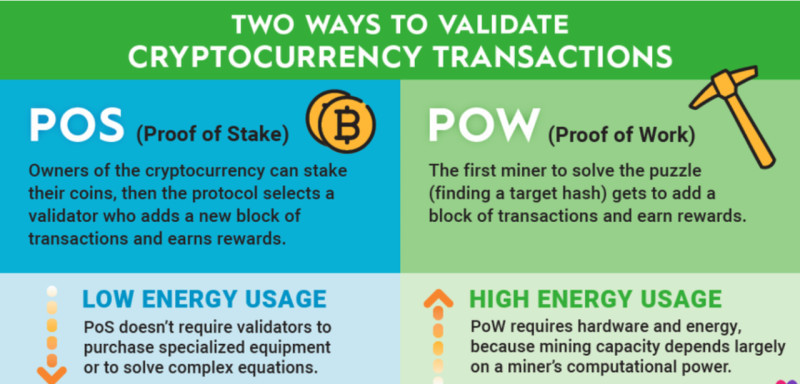
Thirdly, it is essential to understand the blockchain architecture – this means defining its main characteristics. Options in this category include whether it will be private or public, among others.
Fourthly, it is important to conduct an audit of the created blockchain, i.e., a vulnerability check of the code. As a rule, specialists who work specifically in this field, rather than just network development, are sought for an audit.
Fifthly, all legal issues must be resolved. Cryptocurrencies have varying legal statuses in different countries: in some, they are recognized as a means of payment and can circulate freely, while in others, they are completely or partially banned.
In addition to this, it is essential to understand that creating a coin is only part of the task. Equally important issues that need to be addressed include promotion, community building, so that the currency is integrated into the existing system.
Is it difficult to create cryptocurrency?
The internet is full of tutorials and informative articles on how to independently develop your own digital coin or token. Therefore, the question of who created cryptocurrency is now less relevant, as nowadays practically anyone can do it.
Nevertheless, it is important to understand that creating a truly new digital currency, especially based on a new blockchain, is not such a simple task. The pioneers in this field are aptly called "crypto geniuses".
The operation of the blockchain is based on solving complex mathematical problems. Of course, these tasks are mainly performed by powerful, modern computers, more precisely their network, but people are still at the forefront of this entire network.
As we have already seen from the previous sections, entire groups of programmers often worked on the development of the most popular digital currencies. Yes, perhaps only some of them gained fame, but doing such a thing alone is practically impossible.
If we are talking about creating a completely new coin, a large team is needed, as well as a lot of time and financial resources. Creating a token based on an existing network is, of course, a much simpler task.
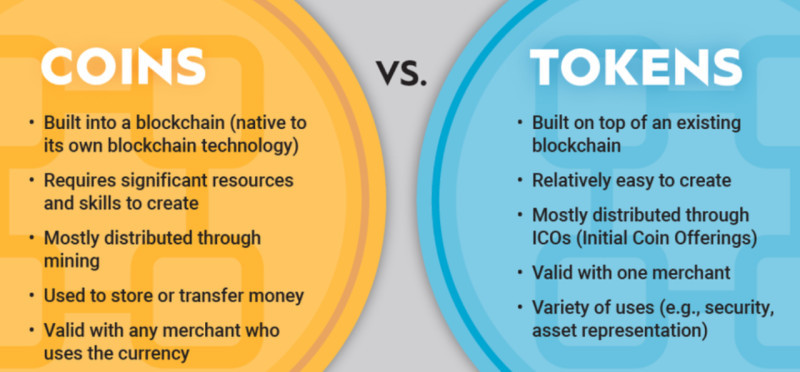
Examples of tokens include any in-game currencies and those intended for use in specific services. That is, such tokens are not universal and can only be used within the platform for which they were developed. Coins, on the contrary, can be used across different platforms.
Nevertheless, for coins to be profitable, it is not necessary for them to be widely known to the masses. What's important is the idea that will make the new currency stand out from millions of others, or some other advantages, such as a more attractive offer than competitors.
Coming up with something new can be challenging, but it's possible to try to monetize things people are already familiar with. For example, many people have recently started to pay more attention to their health and have taken up physical activity. A group of developers noticed this trend and came up with a project that awards tokens for physical activity.
How to create NFT
There is a special category of tokens – NFTs, which are non-fungible, meaning they are unique and one of a kind. It is believed that creating NFT works is easier than other digital assets. Let's explore if this is true in this section.
To develop an NFT token, in-depth programming knowledge is not required. We've already talked about the importance of the concept in creating any digital token or coin, and here the idea takes center stage.
The concept of NFTs is often associated with art and collectibles, but it is not limited to these areas only. An NFT itself is not the artwork but an electronic certificate confirming ownership of a certain digital asset.
For the creator of any unique work, such as a painting or a piece of music, it is an opportunity to confirm their authorship, as well as additional opportunities to monetize their product. The same applies to trademarks, brands, and company logos.
To create your own NFT token, you need just three things:
The artwork or property you want to convert into an NFT;
A cryptocurrency to pay for the minting fee;
A digital wallet.
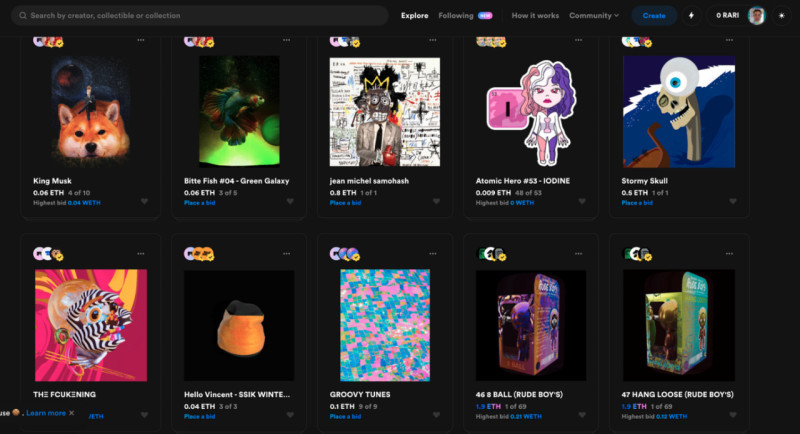
If you already know which file or work will be used to create the unique token, the process itself takes only a few minutes. You need to register on a special platform, upload your file, specify the number of copies and other data. You can also create collections by choosing a logo and adding a description.
How much does it cost to create cryptocurrency
There's no definitive answer to how much it costs to create a new digital currency, as it depends on a multitude of factors previously mentioned.
Broadly speaking, creating a new coin from scratch might cost between $20,000 and $40,000. If the discussion is about a simple token based on an existing blockchain, the cost could be as low as $50.
Special services, or so-called constructors, exist for creating tokens, which already have all the necessary components for creating new digital currencies. Additionally, there are crash courses that teach token creation in a short period.
However, another fact is that there are currently about 1.8 million different digital currencies, with only about 100 of them being well-known. This reaffirms that creating a coin or token is only half the battle, as like any project, it requires promotion.
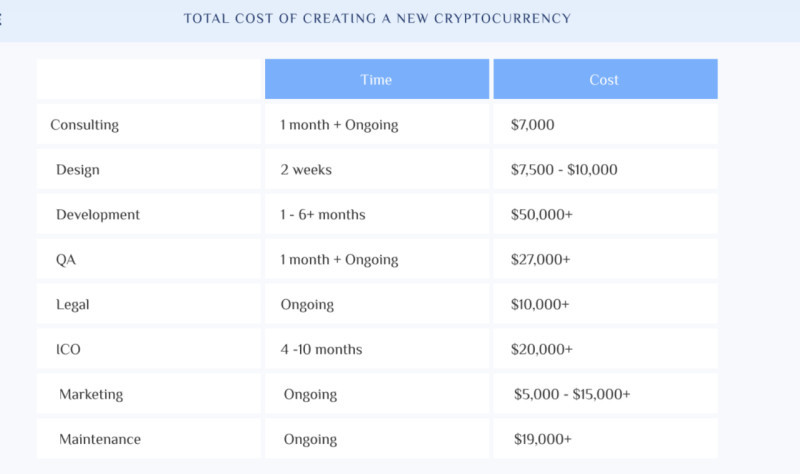
In reality, anyone can create their token – it's not that complicated. However, the coin itself is worthless and meaningless to everyone else except its creator until it becomes well-known. After all, the entire digital money system is built on user trust.
No one will invest in an unknown project until they are convinced of its potential and success. To popularize new currencies, one can enlist famous media personalities, list coins on exchanges, etc.
Money and time are required for this; a website needs to be created, and promotion through SEO with keywords must be done. Various companies offer their services for promotion, sometimes as complete packages that include everything from website creation to social media promotion.
Digital platforms such as Facebook, Telegram, and Instagram are used to promote cryptocurrencies. Currently, the digital currency niche holds leading positions in advertising on Telegram. The cost of such advertising per 1,000 views can reach $100 or more.
Conclusion
This article explored fundamental questions about who created cryptocurrency and how it was developing. The idea of digital currencies emerged long before the first coin, Bitcoin, appeared.
The concept of a decentralized payment system, not tied to banks or other financial organizations, arose in the 1980s. Some scientists developed their attempts to launch digital currencies but were not successful.
Bitcoin became the first successful when was the first cryptocurrency created, appearing only in 2009. The name of its creator is known, but it is a pseudonym, and who is behind it remains unknown. There are several "candidates" for the role of Bitcoin's creator, but none have definitive proof.
As for other well-known cryptocurrencies, their creators do not hide their names and identities. Moreover, anyone can create their coin or token, although this may require significant financial and human resources.
This is particularly true for creating digital coins from scratch, as their launch can cost between $20,000 and $40,000. However, creating a cryptocurrency is only half the battle, as even more effort and finances will go into promoting the coin, otherwise, the launch will be meaningless.
You may also like:
What is Cryptocurrency Used for
What Cryptocurrency is Backed by Gold
How to Make Money on Cryptocurrency








 Back to articles
Back to articles

